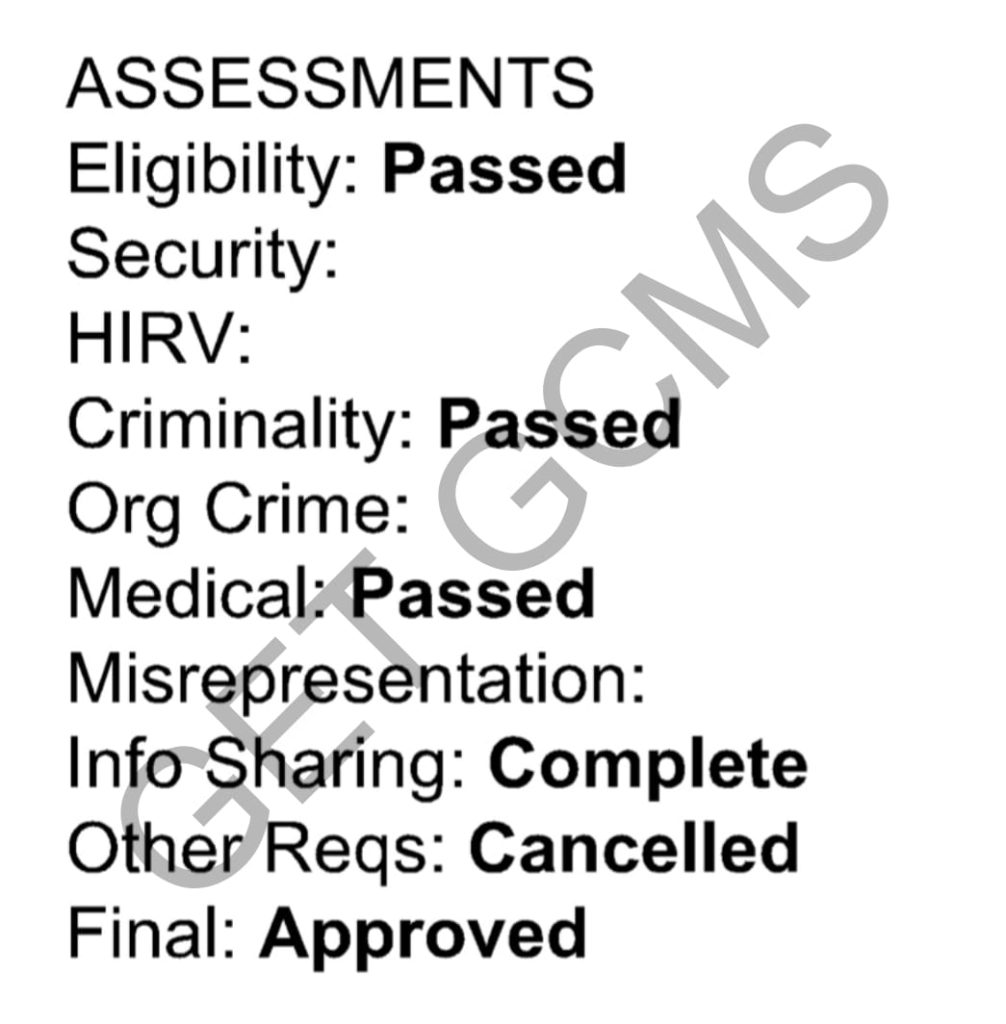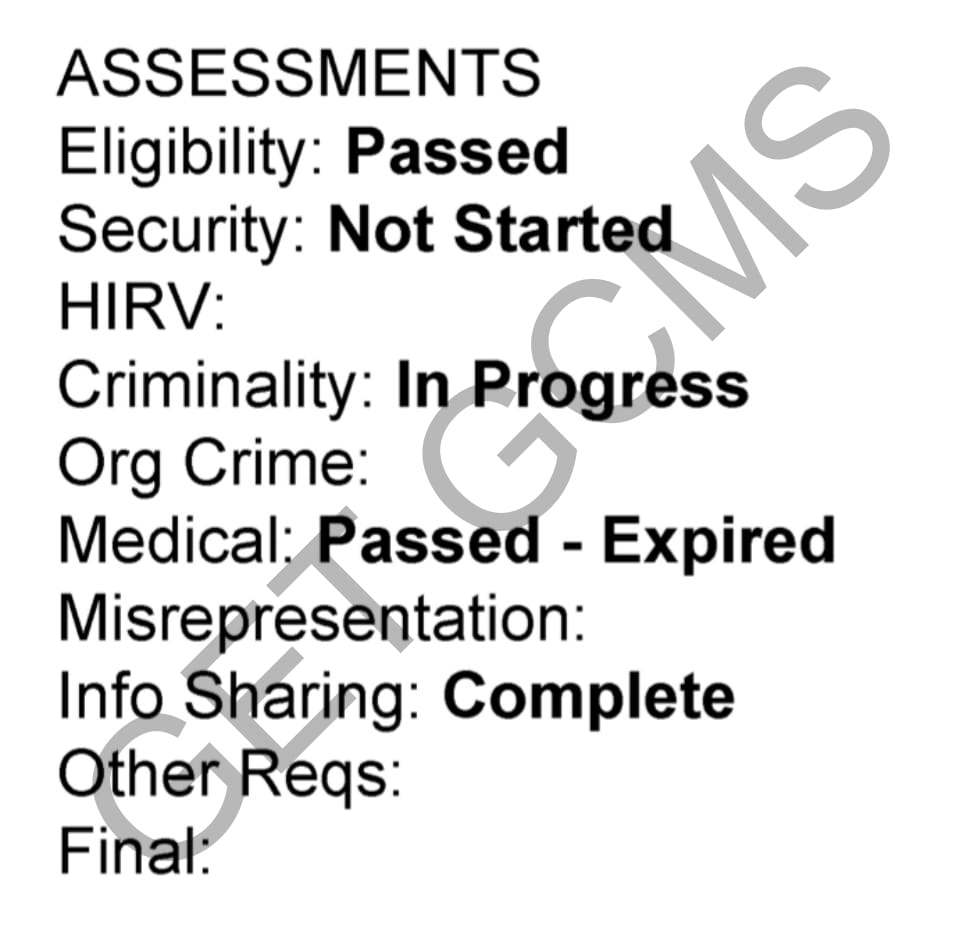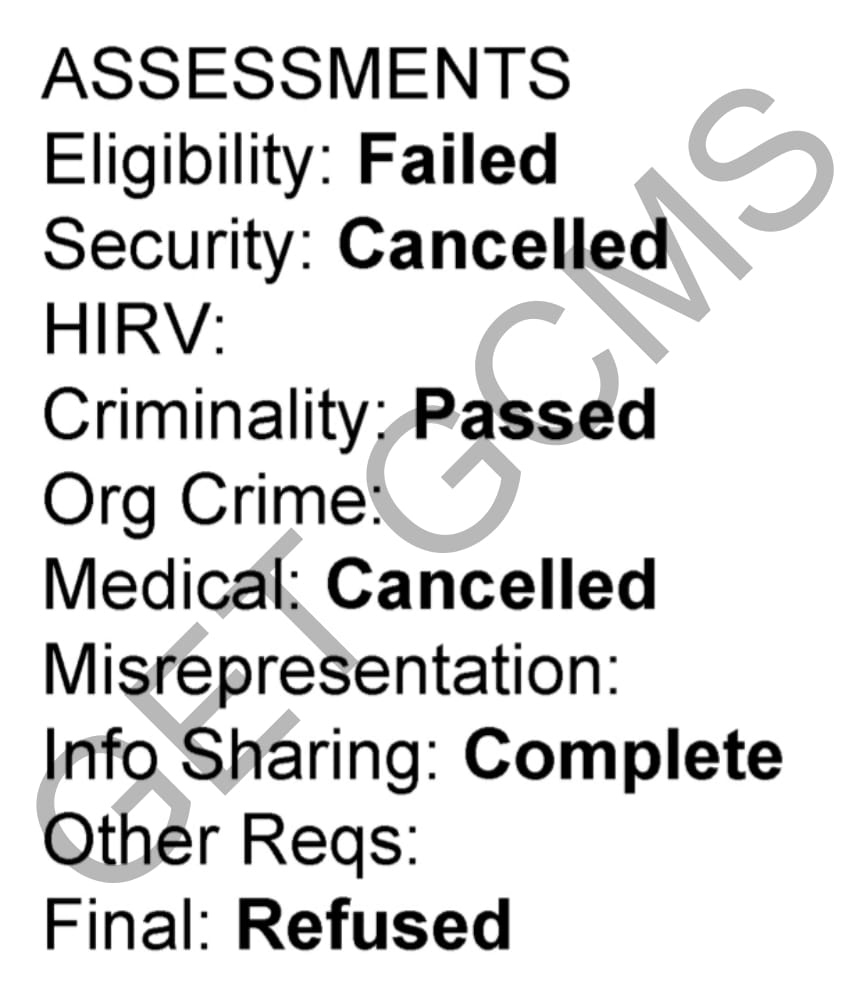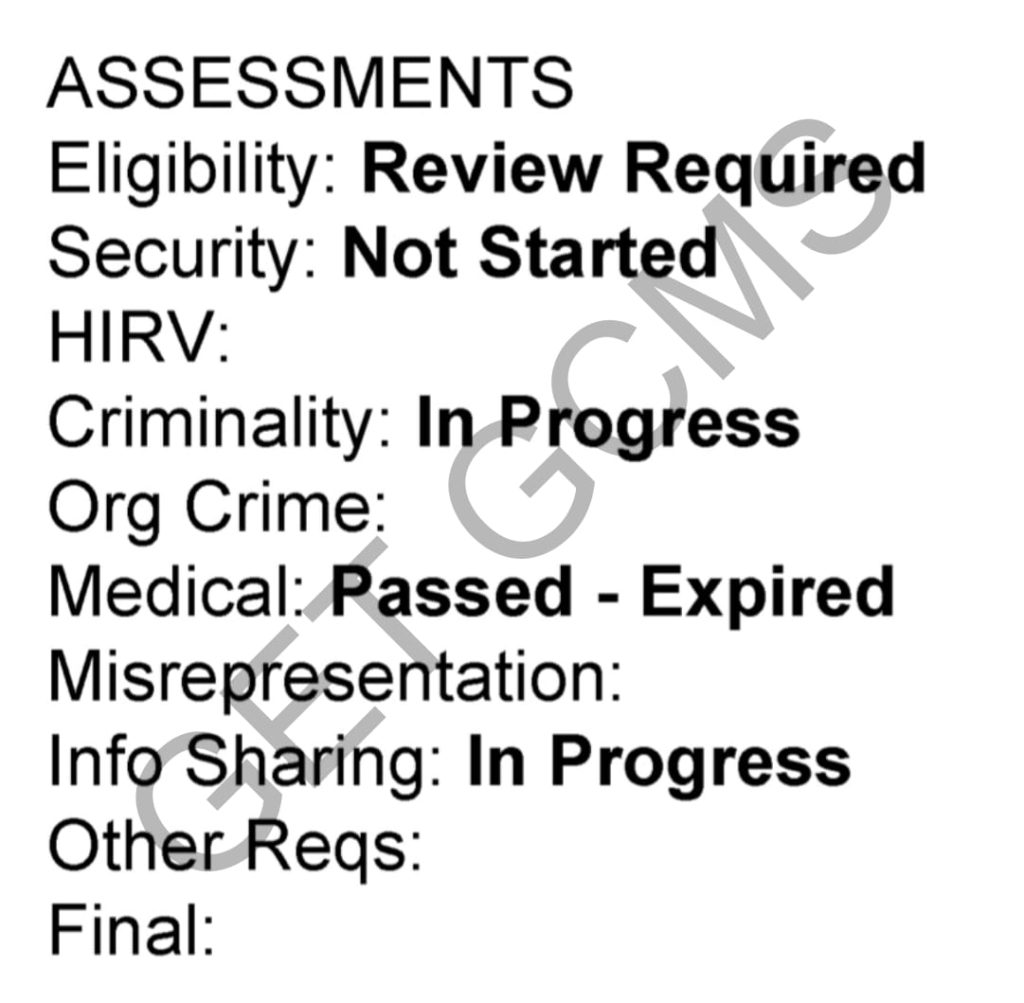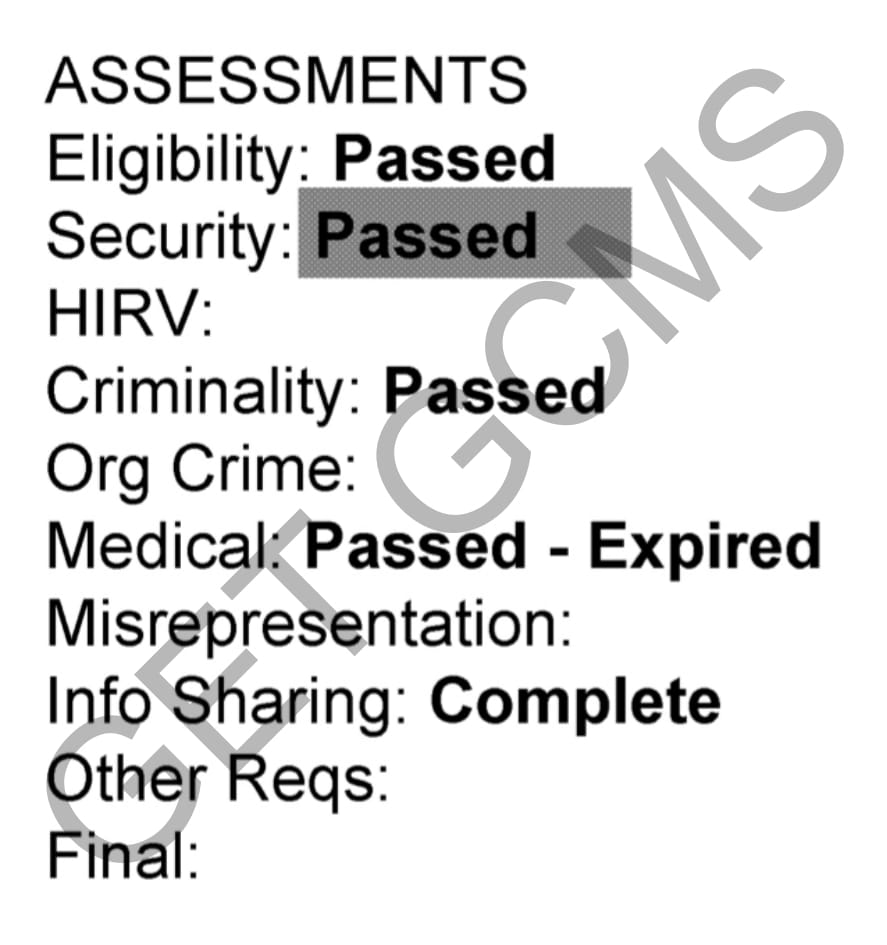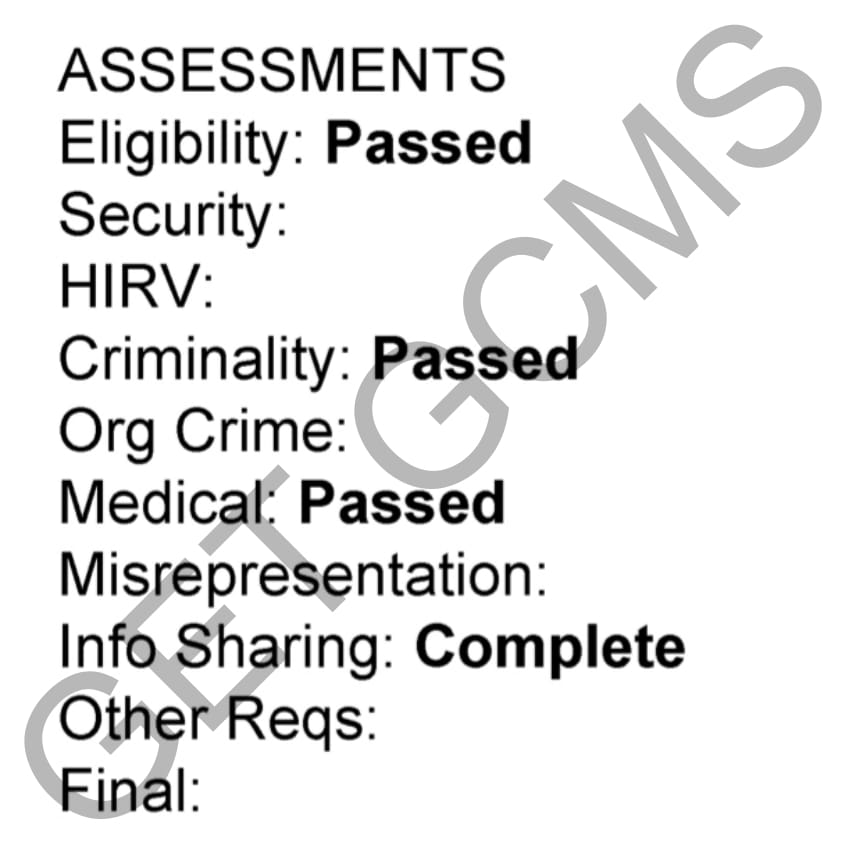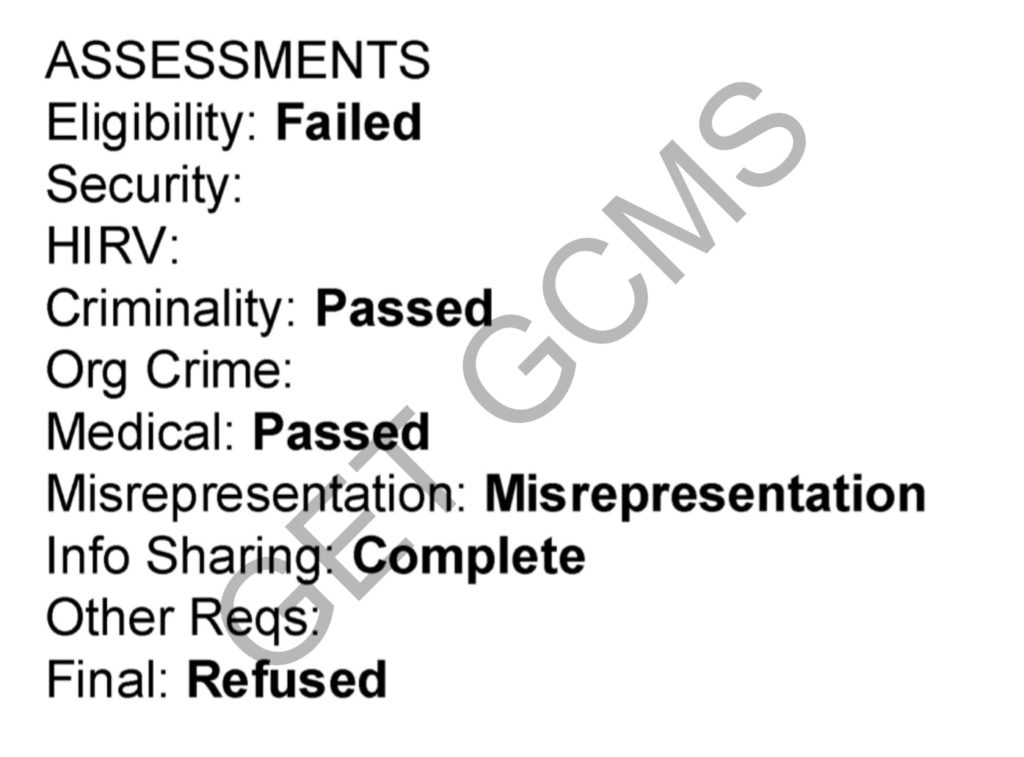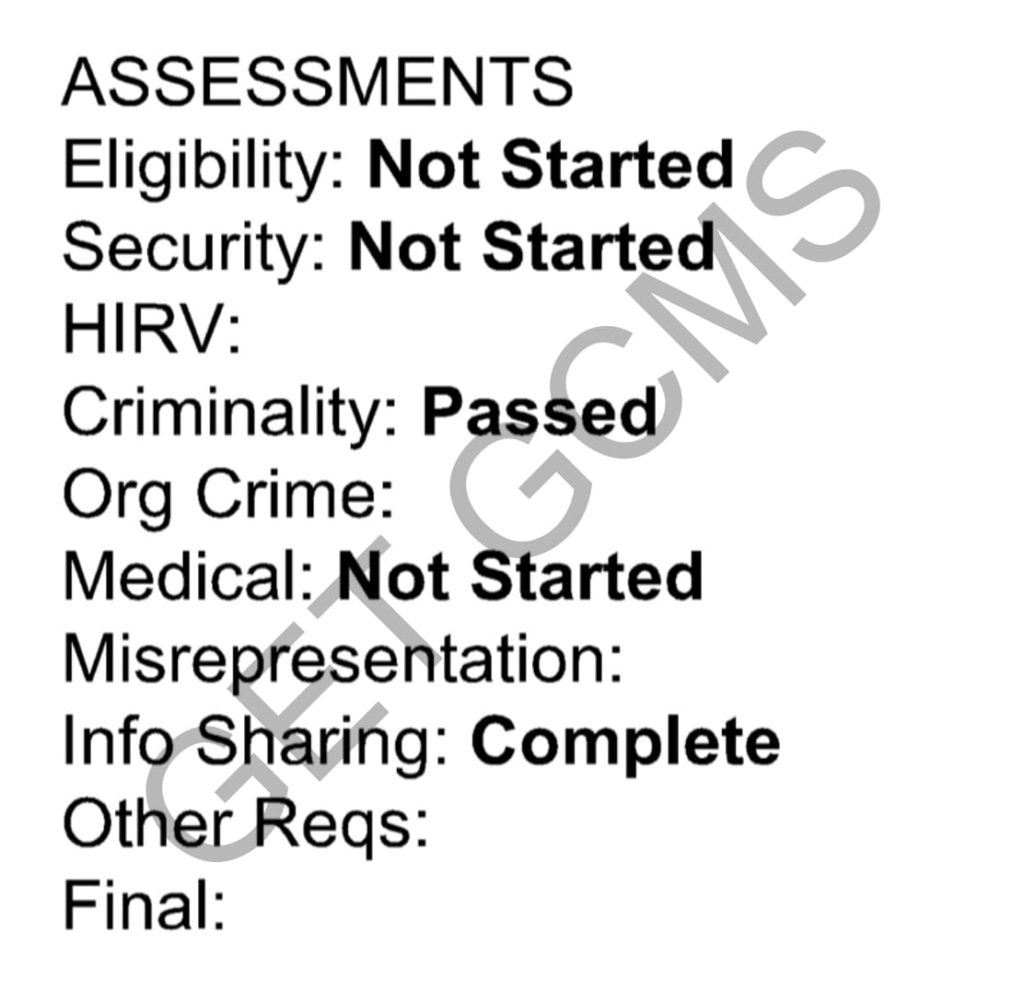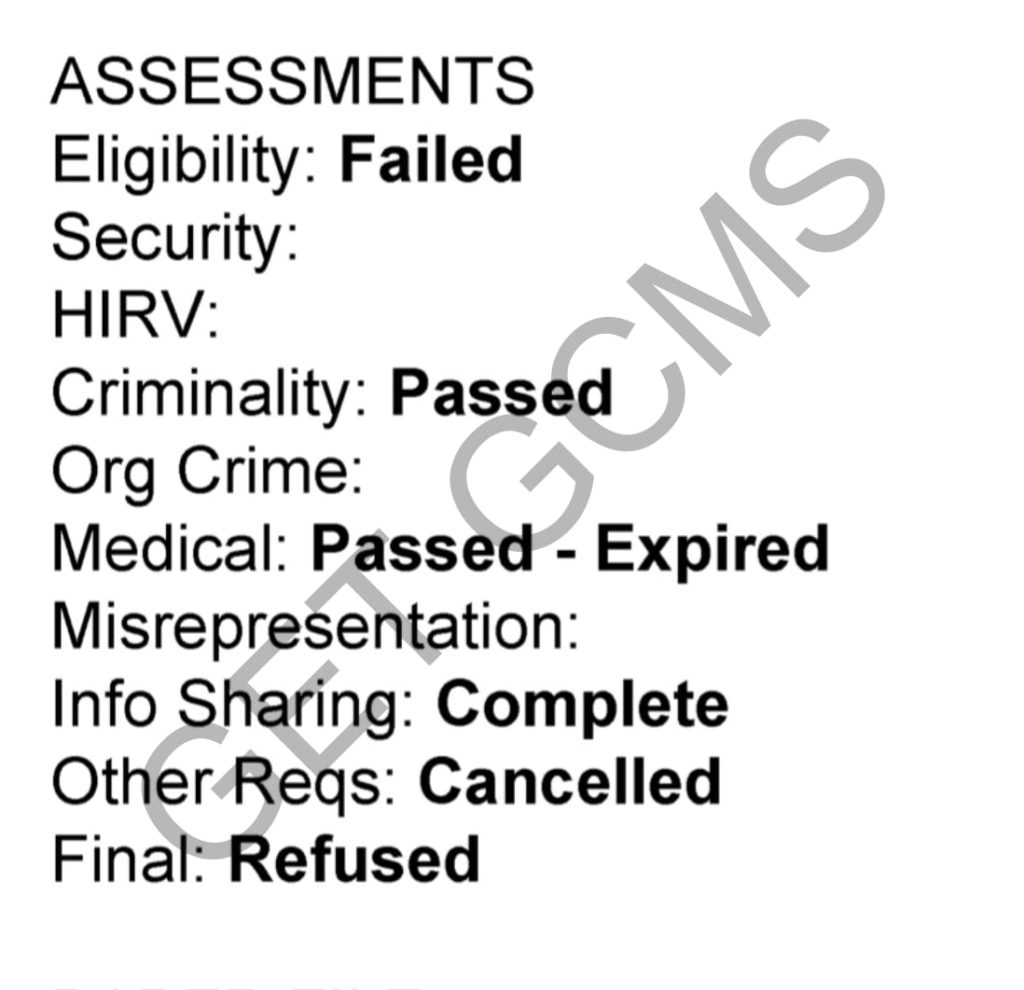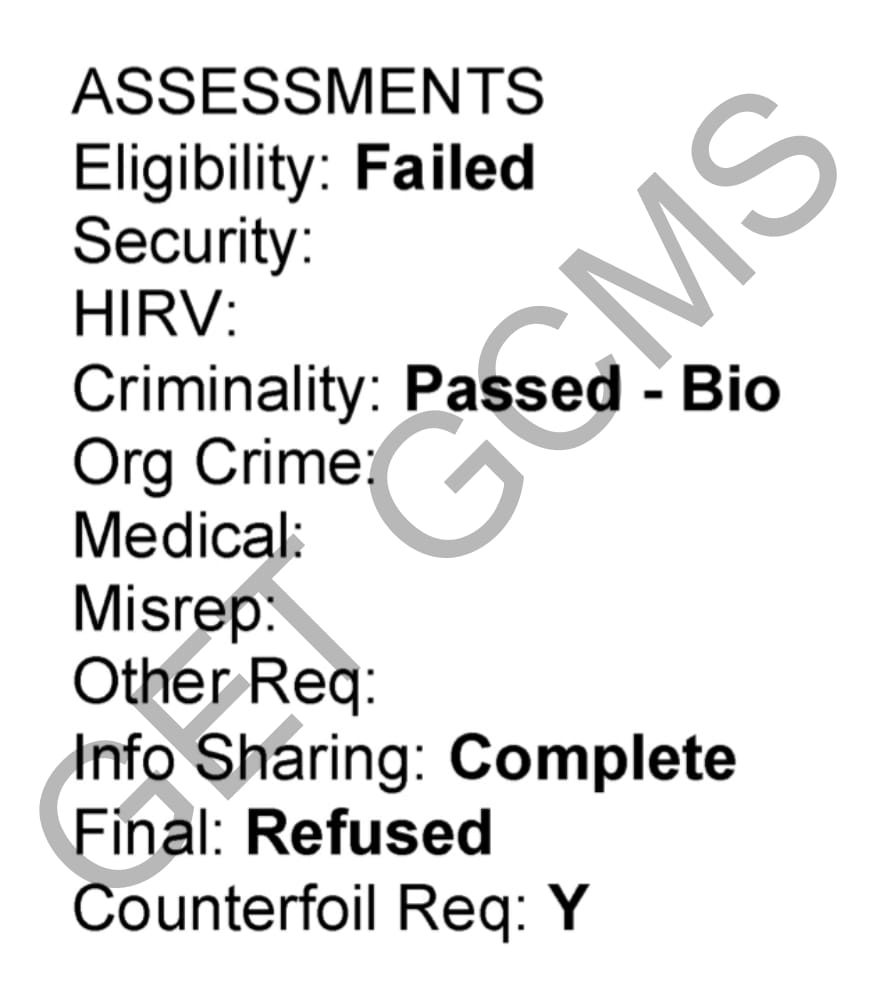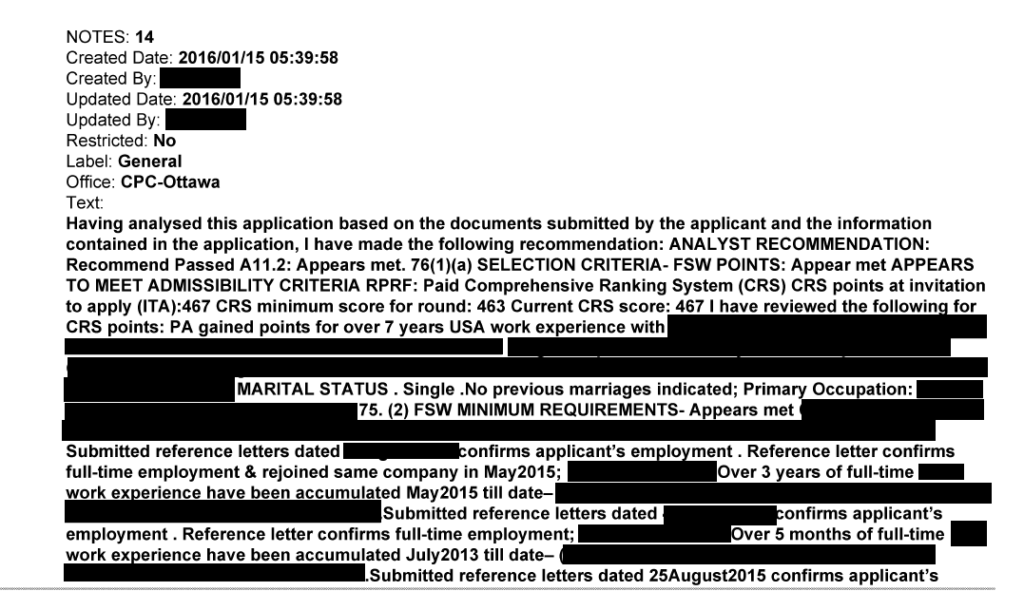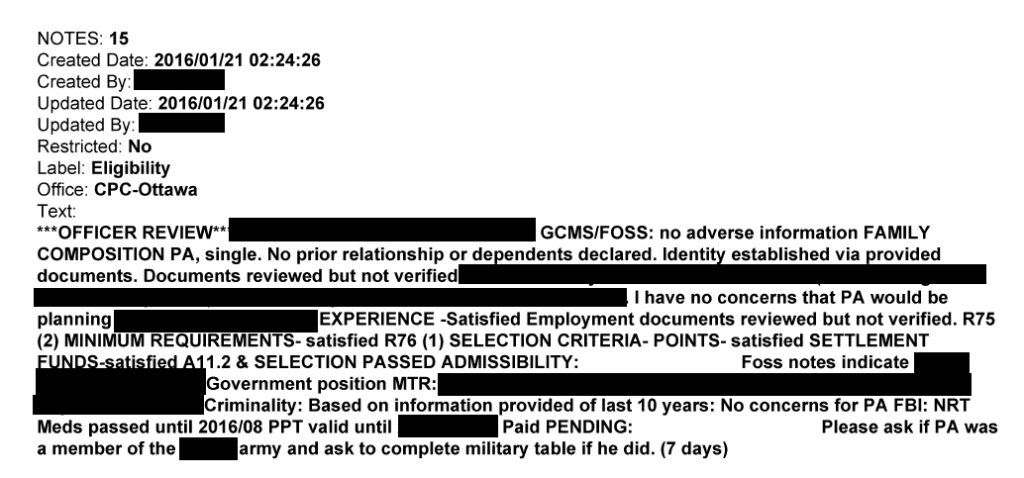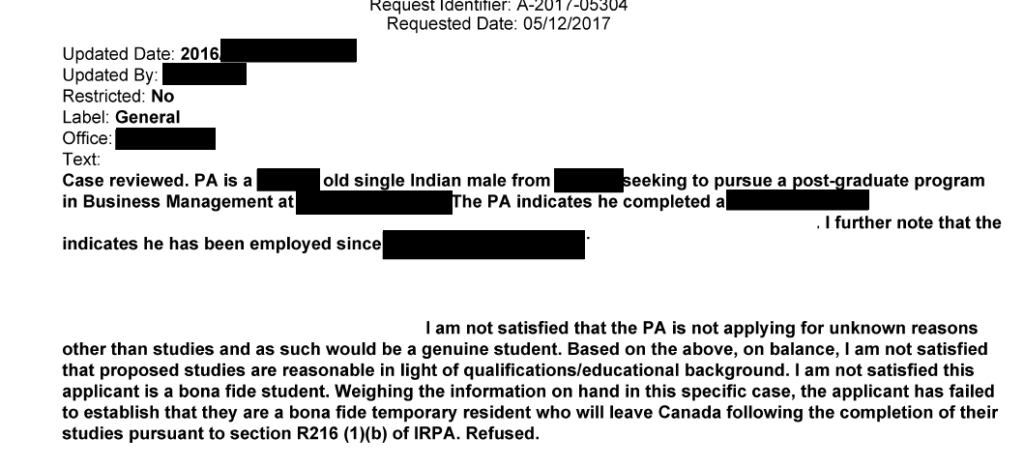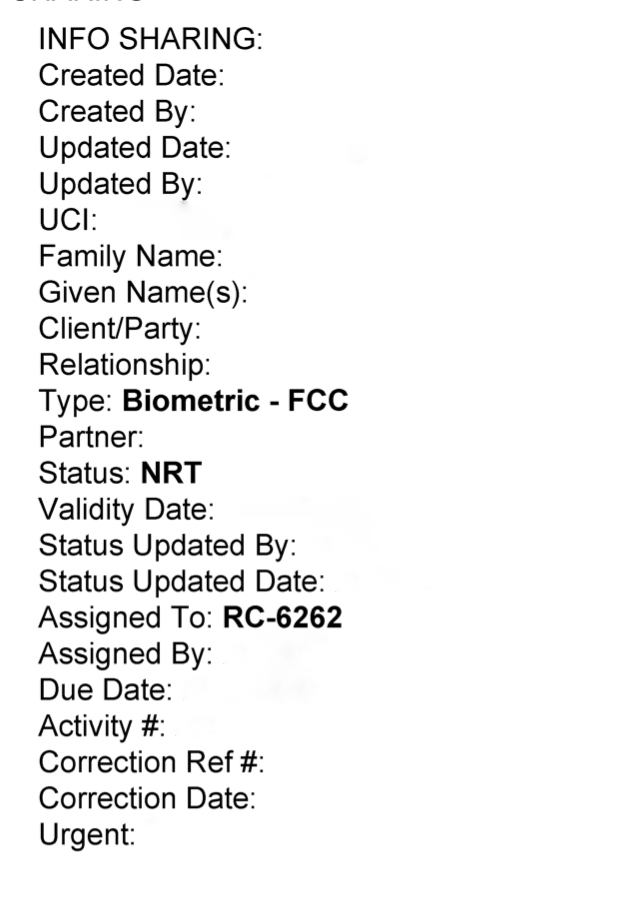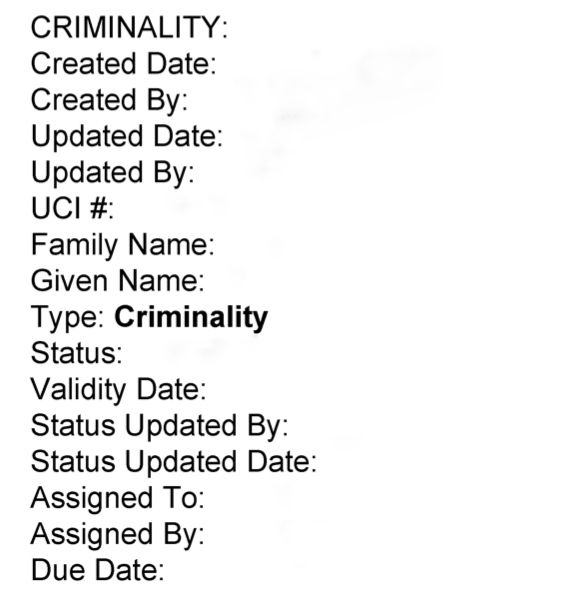The GCMS notes provide an overview of the processing details of your immigration/visa application and the reasons for the refusal, if applicable. In most cases, you can interpret GCMS notes, read and understand them easily. All GCMS notes are structured in a similar way and follow the same pattern. The GCMS notes also have the notes of an officer who is reviewing your application and/or made a decision on your application. Some of the notes and entries will refer to abbreviations, which have been explained in the article below.
The Structure of the GCMS notes
All GCMS notes released by IRCC or CBSA follow the same structure. If you received the newer abridged format of the GCMS notes, refer to the section below. The GCMS notes are arranged in the following sections.
- Application and Primary Applicant details – Page 1
- Assessment summary – Page 2
- Application assignment and secondary offices – Page 2 & 3
- Client details – details of all the individuals in the application – usually page 5 or 6
- Eligibility – CRS score, Language score, employment history, Education history
- Admissibilities –
- Security;
- HIRV (Human and International Rights Violations);
- Criminality;
- Biometrics;
- Medical;
- Misrepresentation; and
- Info Sharing.
- Finalize application – Document Issuance / Refusal Grounds
- Correspondence
- Appeals and Litigation
- Fees
- Associations
- Online Activity History
- EDOCS (Electronic documents)
- Notes
Structure of the newer abridged GCMS notes
Starting June 2021, IRCC and CBSA have started releasing the newer abridged format of the GCMS notes for some requests. The abridged format is an extract from the GCMS notes and provides only the relevant information in 5-15 pages. The notes only release what is applicable to the application, and remove all unnecessary details including the calculations, incoming and outgoing correspondence, electronic documents etc. They are structured as follows:
- Application details, client status details and assessment summary
- Individuals in the application
- Client details
- Admissibilities (only what is applicable will be issued)
- Security;
- HIRV (Human and International Rights Violations);
- Criminality;
- Biometrics;
- Medical;
- Misrepresentation; and
- Info Sharing.
- Finalize application – Document Issuance / Refusal Grounds
- Fees
Guide to Interpreting and reading the GCMS notes
Reading and interpreting the GCMS notes is a fairly easy task and is not as daunting as it may seem for most applicants. If you follow the following steps, you should be able to easily figure out which stage your application is at and the corresponding notes an officer may have entered about that stage.
Step 1 – Verify your details
After you receive your GCMS notes, the first and foremost thing you should do is to verify that the GCMS notes are for your application. Verify the application number, UCI number, name and date of birth on page 1 of the notes to make sure that you received the correct GCMS notes.
Step 2 – Check the assessment summary
On page 2 of the GCMS notes, or page 1, if you received the newer abridged format of the GCMS notes, you will have a summary of the assessments. All the stages of application processing are summarized in this section. This section gives you an overview of the current status of your application, and if a decision on your application has been made. Some of the assessment section samples are provided below.
In the assessments section, the entries listed refer to the following:
1. Eligibility
Refers to the eligibility criteria for the immigration program (FSW / CEC / FST / PNP) you applied for, or the eligibility for the visa application (visitor’s visa/work permit/study permit) you applied for.
2. Security
Before foreign nationals who apply for a visa, permanent residency or file any other immigration application can be admitted into Canada, it has to be ensured that they would not present a risk to the safety or security of Canadians. All foreign nationals undergo a security screening, which is done primarily by partner agencies, such as CBSA and CSIS. You can read an in-depth article on security screening here. GCMS notes released by IRCC will redact the security-related information in the GCMS notes pursuant to section 15 / 16 of the Access to Information Act. If the security screening has not yet started the security field will reflect “not started” against it. However, if it is in progress or passed, it may show as blank and have s15/16 listed on the top right corner of the page.

To obtain the details of the security-related information you can consider requesting CBSA notes. Most notes released by CBSA do not have security-related information redacted.
3. HIRV (Human or International Rights Violation)
Canada denies safe haven to war criminals and persons believed to have committed or been complicit in Crimes Against Humanity and War Crimes. The Immigration law specifically makes a foreign national inadmissible on grounds of violating human rights or international rights for:
(a) committing an act outside Canada that constitutes an offence referred to in sections 4 to 7 of the Crimes Against Humanity and War Crimes Act
The details of how admissibility for HIRV is carried out can be read here.
For most applicants this section would not be applicable and would remain blank.
4. Criminality
A foreign national is inadmissible on grounds of serious criminality for:
- having been convicted in Canada of an offence under an Act of Parliament punishable by a maximum term of imprisonment of at least ten years, or of an offence under an Act of Parliament for which a term of imprisonment of more than six months has been imposed
- having been convicted of an offence outside Canada that, if committed in Canada, would constitute an offence under an Act of Parliament punishable by a maximum term of imprisonment of at least ten years
- committing an act outside Canada that is an offence in the place where it was committed and that, if committed in Canada, would constitute an offence under an Act of Parliament punishable by a maximum term of imprisonment of at least ten years
A foreign national is inadmissible on grounds of criminality for:
- having been convicted in Canada of an offence under an Act of Parliament punishable by way of indictment, or of two offences under any Act of Parliament not arising out of a single occurrence
- having been convicted outside Canada of an offence that, if committed in Canada, would constitute an indictable offence under an Act of Parliament, or of two offences not arising out of a single occurrence that, if committed in Canada, would constitute offences under an Act of Parliament
- committing an act outside Canada that is an offence in the place where it was committed and that, if committed in Canada, would constitute an indictable offence under an Act of Parliament
- committing, on entering Canada, an offence under an Act of Parliament prescribed by regulations
Criminality assessment for permanent resident applicants is based on the police clearance certificates, biometrics and the checks done by IRCC / CBSA. If the criminality assessment has not yet started, it will show as blank. If it is in progress or passed, then the same will be reflected accordingly.
5. Organised Crime
A permanent resident or a foreign national is inadmissible on grounds of organized criminality for:
- being a member of an organization that is believed on reasonable grounds to be or to have been engaged in activity that is part of a pattern of criminal activity planned and organized by a number of persons acting in concert in furtherance of the commission of an offence punishable under an Act of Parliament by way of indictment or in furtherance of the commission of an offence outside Canada that, if committed in Canada, would constitute such an offence, or engaging in activity that is part of such a pattern
- engaging, in the context of transnational crime, in activities such as people smuggling, trafficking in persons or money laundering
If a foreign national is suspected of having been involved in organized crime, the assessment would reflect the same. If this assessment is not applicable, it will remain blank.
6. Medical
A foreign national is inadmissible on health grounds if their health condition is likely to be a danger to public health, is likely to be a danger to public safety, or might reasonably be expected to cause excessive demand on health or social services. To read more details on how medical admissibility is done click here. If the medical admissibility is passed, “PASSED,” will be reflected against this field. If the medicals are not passed, “FAILED” will be reflected against this field. If medical admissibility has not yet started or is in progress, this field will be blank.
7. Misrepresentation
A permanent resident or a foreign national is inadmissible for misrepresentation
- for directly or indirectly misrepresenting or withholding material facts relating to a relevant matter that induces or could induce an error in the administration of the Immigration and Refugee Protection Act
- for being or having been sponsored by a person who is determined to be inadmissible for misrepresentation
Misrepresentation can result due to submitting fraudulent documents, falsifying documents, providing incorrect or misleading information, purposefully failing to disclose relevant details etc. If a finding of misrepresentation is concluded for an applicant, “MISREPRESENTATION” will be listed against this field. If there is no fining of misrepresentation, the field will remain blank.
8. Info-Sharing
The object of information sharing is to support the effective administration and enforcement of Canada’s citizenship and immigration programs. IRCC has agreements with domestic and international partners and shares information pursuant to such agreements that aid in the investigation of matters relating to immigration fraud, criminality, public safety and health; facilitate provincial and territorial immigration programs and settlement services, and further Canada’s public safety and security objectives of combating international terrorism, war crimes, crimes against humanity and organized crime. To read more on info-sharing click here.
Info-sharing is done based on the requirements of an application. If applicable, the field will show the status of info-sharing as “in progress,” “complete” or “not started“
9. Other Requests
This field is only applicable if any requests have been sent to other departments or visa offices to assist the processing of an application. If no requests have been made, it will be blank, and if any requests were made, which were subsequently cancelled, it will show as “cancelled.”
10. Final
This field depicts the final decision on the application. If no decision has yet been made, it will be blank. If a decision has been made, “APPROVED” or “REFUSED” will be reflected against this filed.
Step 3 – Officer’s notes
The officer reviewing the visa or immigration application will enter her notes. These notes are entered for eligibility in case of permanent residency applications, and also when an application is refused. The notes that are entered are numbered, have a date when they have been entered and the label reflecting the processing stage they pertain to. The notes are numbered, with the most recent note being at the top, followed by older notes. The officer’s notes provide detailed reasoning on why an application was refused.
For permanent residency applications, the notes are entered for different stages of the processing, such as completeness check, eligibility, any information sought from the applicant etc.
Other information that can be obtained from the GCMS notes
With the above, most applicants will have a very clear understanding of what stage their application is at, and if it was refused, the reasons for the refusal. For those who want to get into further details, the following is also available in the GCMS notes:
a. Visa office where an application is being processed.
See application details >>>> Secondary offices>>> Pg 1-4
The primary visa office where the application is assigned is based on the country of residence of an applicant. The primary visa office is listed on page 1 of the GCMS notes. During the processing of an application, it can be transferred to any visa office across the IRCC network., referred to as secondary visa offices. The secondary visa offices where an application has been or is being processed along with the date when it was assigned to the visa office are listed on page 2 of the GCMS notes.
These visa offices are referred to by their codes, called “responsibility centre” (RC) codes. Some of the common RC codes are:
- RC-9515: Case Processing Centre, Ottawa
- RC-8090: Case Processing Centre, Sydney
- RC-6100: Visa Office, Accra
- RC-6029: Visa Office, New Delhi
- RC-9245: Operations Support Centre (OSC)
- RC-6262: Centralized Intake Office (CIO)
- RC-9518: Case Processing Centre, Edmonton
- RC-3296: Visa Office, Etobicoke
b. Calculation of the comprehensive ranking score (CRS)
See Eligibility>>>>>Assessments>>> Pg. 6-9
An applicant’s CRS score is automatically recorded in GCMS at the time when
- their Invitation to apply (ITA) is issued; and
- their electronic application (e-APR) is submitted.
All the factors for which the score has been awarded to an applicant are recorded and are available under the “Eligibility” section of the GCMS notes, after client details. The factors for which the CRS score is awarded are not available in the newer abridged format of the GCMS notes. These factors include education, age, employment, job offer, language proficiency etc.
The entries in this section show the entries reflecting “Candidate Passed.” This should not be confused with the eligibility summary as passed. Here, “Candidate Passed” means that based on the inputs of an applicant in the profile, the application meets one of the programs under express entry making the applicant eligible to apply. However, to know where the eligibility is passed, see the notes in the last few pages and the summary assessment on page 2.
c. When the processing of a specific stage started and its current status
See Admissibilities>>>Security>>>HIRV>>>Criminality>>Medical>>>Misrepresentation
The details about the processing of each admissibility factor (stage), i.e. all the assessments mentioned in step 2, through which an application undergoes and its current status are available under “Admissibilities.” All activities under each admissibility and the status are entered along with the date when it was initiated and if it has been passed. The activities and sub-activities for each admissibility will provide a detailed overview on the date when it was created, it started, the current status, the office it has been allocated to, and until when it is valid for (if applicable).
These activities and sub-activities look like the following:
d. Medical admissibility code
While the summary assessment on page 2 only informed where the medical admissibility is passed or not, but does not show the code that has been allocated after the assessment. To know the code, scored down in the GCMS notes, under admissibilities and then under medicals, where the code is entered. The medical admissibility codes are as follows:
| M1 | No public health risk or danger, no public safety danger and no excessive demand |
| M2 | Potential risk to public health. Medical surveillance required. Conditional entry recommended if granted entry to Canada. For example, applicants may be a “risk” due to a communicable disease that may reactivate, such as inactive tuberculosis. |
| M3 | A health condition(s) is present but is not expected to place an excessive demand on health or social services. |
| M4 | Inadmissible due to danger to public health, e.g., active infectious tuberculosis. |
| M4/4 | Closed medical file due to NON-compliance from the applicant specifically related to tuberculosis. Note: In GCMS, the file is simply “closed”; the M4/4 code is only used in IMS. |
| M5 | Inadmissible due to excessive demand on health and social services. For all M5 codes, the medical officer will add a descriptive code indicating the nature of the excessive demand: • T9 – for excessive demand on social services; • H9 – for excessive demand on health services; • E9 – for displacement of Canadians who are on a waiting list. |
| M6 | Inadmissible due to danger to public safety, e.g., psychopathic personality. |
| M6/6 | Closed medical file due to NON-compliance from the applicant. Note: In GCMS, the file is simply “closed”; the M6/6 code is only used in IMS. |
For a complete list of medical codes click here.
The medical admissibility activity looks like the following:
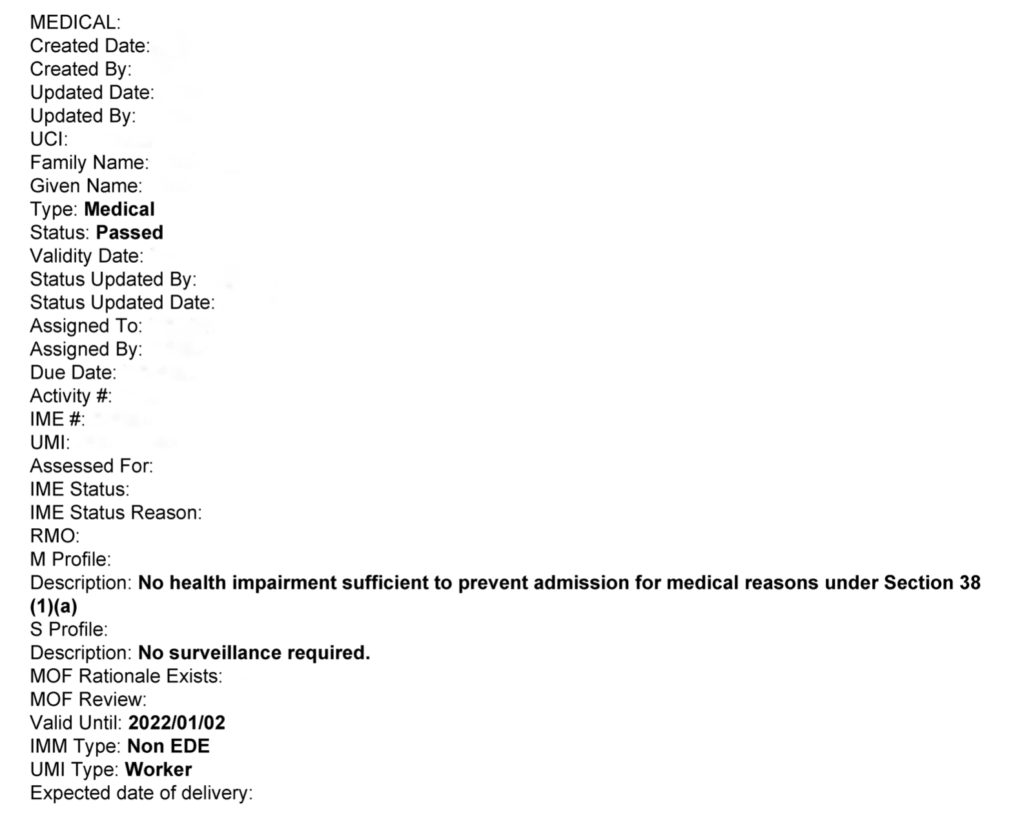
f. Correspondence
Under the correspondence section, all incoming and outgoing correspondence sent to and from IRCC is listed. This lists any requests for additional documents, forms, information, acknowledgement of receipt, request for RPRF etc. The incoming correspondence includes all the documents submitted along with the application, which are individually entered, and any webform or emails sent after the submission of the e-APR.
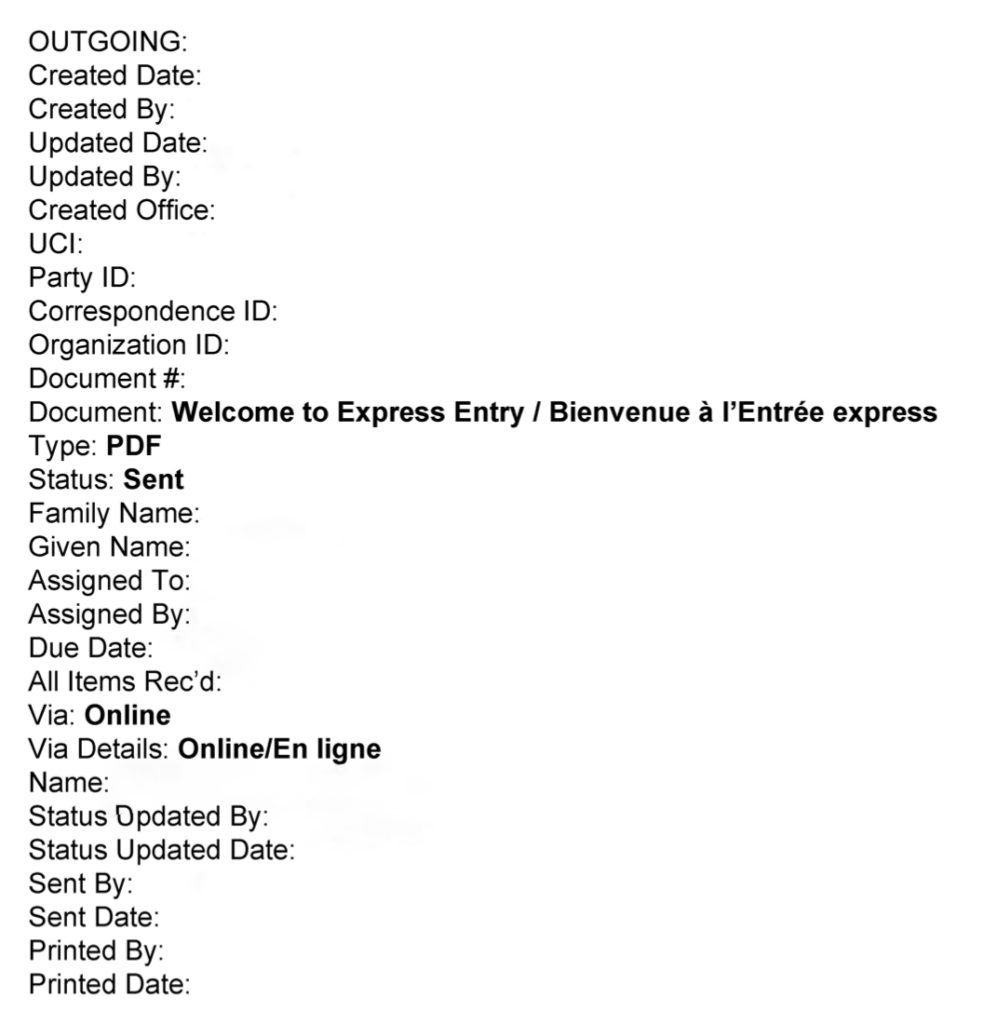
g. Ancillary information
Apart from the above, if the application has been approved, a document number will be available, which is usually the COPR number for permanent reside applications, or a visa number for TRV applications. Scrolling through other pages, more information about how each document submitted by an applicant is numbered, the fee payment details, litigation details (if applicable), etc. are also available.
Legal references and abbreviations used to understand and interpret GCMS notes
| R87 | Eligibility for Provincial Nominee Class |
| R87.1 | Eligibility Canadian Experience Class |
| R87.2 | Eligibility Federal Skilled Trades Class |
| R75-85.6 | Eligibility Federal Skilled Worker Class |
| R10 | The requirement to submit a complete application (completeness check) |
| A11.2 | The requirement to maintain qualifications and change in circumstance |
| R67 | Applicants outside Canada |
| R68 | Applicants in Canada |
| NRT | No reportable Trace |
| BGC | Background Check |
| EE MI | Express Entry Ministerial Instructions |
| FINDEC | Final Decision |
| FOSS | The Field Operations Support System Immigration, Refugee and Citizenship Canada (“IRCC“) and CBSA’s shared database. |
| IME | Immigration Medical Examination |
| NAI | No Adverse Information |
| NSSD | CBSA’s National Security Screening Division |
| PPV | Passport with Visa |
Conclusion
Reading and interpreting your own GCMS notes is a fairly easy and simple task. The above guide and references to other blog pots and external links should place you in a very strong position to read your own notes and understand the the precessing details of your application, and reasons for refusal (if applicable).
This post will be updated from time to time to add more relevant information to assist applicants in reading and interpreting the GCMS notes.
GCMS notes are the only way to accurately know the processing details of an application or why it was refused. You can order your GCMS / CBSA / CSIS notes online.
DISCLAIMER: Our website contains general legal information. The legal information is not advice and should not be treated as such. The legal information on our website is provided without any representations or warranties, express or implied. Further, we do not warrant or represent that the legal information on this website: will be constantly available, or available at all; or is true, accurate, complete, current or non-misleading. No lawyer-client, solicitor-client or attorney-client relationship shall be created through the use of our website.

